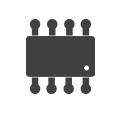BATTERY MONITORING
Autonomous battery-powered telecommunications system
Monit’O is used to check that the photovoltaic solar panels and wind turbine assembly generates enough energy for the communication system’s battery.
Battery monitoring, including charge voltage and charge current
The Monit’O sensor is used to meet battery monitoring requirements ; it periodically transmits measurements of the battery’s charge voltage and input or output current over the LoRaWAN network. The remote application can then calculate the battery’s current state of charge.
Technically speaking, the sensor is designed to measure the charge voltage up to 70 V and the voltage of a 100 mV shunt through which the charge current flows. To measure the charge current, the shunt must be adapted to the intensity of the electric current that flows in the conductor.
Various shunts are available. Please refer to the DER 100mV table and to the Shunts online documentation (rs-online.com).

Technical description
Two analog inputs isolated from one another allow the measurement of these electrical quantities, 0-100 mV and 0-70 V:
0-70 V measurement
The input that monitors the voltage source is suitable for the measurement of a voltage increase up to 70 Volts:
- non-isolated input
- common mode voltage > 70 V
- -/+ 70 mV measurement accuracy over the range
- 17 mV resolution
- input available for a 1.5 m long cable with 1 pair of 2 AWG 20-26 stranded wires
0-100 mV measurement
The sensor input that monitors the current injected from the voltage measured at the 100 mV shunt (not supplied) is brought back to the 0-100 mV range:
- galvanically isolated input
- 0 to 100 mV range without saturation
- -/+ 1 mV measurement accuracy over the range
- 1 mV resolution
- input available for a 1.5 m long cable with 1 pair of 2 AWG 20-26 stranded wires
Provisions around the 0-100 mV input
Electrical Safety
The characteristics of the 0-100 mV input do not allow intrinsic safety to be implemented on this input. In addition:
- any voltage greater than 1 V (in particular the 0-70 V voltage on the neighbouring input) will be destructive and not covered under the warranty,
- input available for a 1.5 m long cable with 1 pair of 2 AWG 20-26 stranded wires,
- to limit the risk of wiring errors, the cable is identified by a [Shunt] label affixed on the sheath. Each strand is identified by a [+] and [-] label,
- in the event of a wiring error on the input and to protect the installer when the protective cover is open, the electronic board is protected by an elastomer membrane that covers its entire surface.
Disturbances
The 0-100 mV input cable is shielded. The two wires associated with the input are twisted to limit disturbances in common mode.
Either end of the input wires is fitted with a crimped lug to reduce any resistance on the contact points.
Accuracy
The accuracy stated is inherent to the sensor.
Periodicity of measurements and transmission
By default, one measurement on both inputs and transmission once per day, configurable using the LoRaWAN downlink.
WATTECO, your IoT partner

Over 30 years of experience
in the design, development, industrialisation and manufacturing of electronic products

Integrated design office
to develop new concepts according to your constraints

Made in France
our production workshop is based in Lanester (56), France and the company is ISO 9001 certified
